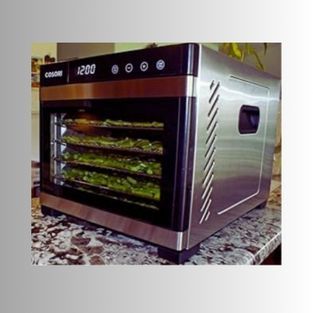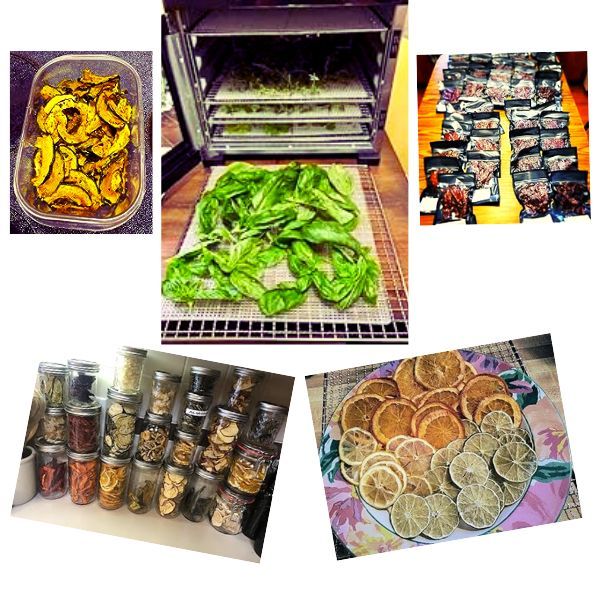From Fruits 🍓🌽 to Jerky 🥩 : Maximize Shelf Life and Flavor!
Welcome to the world of food preservation!
In today's fast-paced world, it's essential to find ways to make our food last longer without compromising its nutritional value and flavor.
One popular method that has stood the test of time is using food dehydrators. These handy appliances allow you to preserve a wide variety of fruits 🍅 🍏 vegetables, herbs, and even meats by removing their moisture content.
Not only does this significantly extend their shelf life, but it also concentrates the flavors and nutrients, giving you a delicious and nutritious snack or ingredient for future culinary adventures.
Let's explore further ...
What is Food Dehydration?
Food dehydration is the process of removing moisture from various food items, such as fruits, vegetables, meats, and herbs, to preserve them for extended periods.
By eliminating water content, dehydration inhibits the growth of bacteria, yeast, and molds that cause spoilage. This preservation method allows for long-term storage without refrigeration while retaining the nutritional value, flavor, and texture of the food.
Dehydrated foods are lightweight, compact, and convenient, making them popular for camping, hiking, and emergency preparedness.
Another food preservation process by drying is freeze-drying. To distinguish one from the other ...
The main difference between food that has been dehydrated and food that has been freeze-dried lies in the preservation process and the resulting characteristics of the food.
Dehydration involves removing moisture from the food by circulating warm air, which causes the water to evaporate. Dehydrated food retains some moisture and has a lower water content compared to its original form but may have a slightly altered texture and flavor. It requires rehydration before consumption.
Freeze-drying, on the other hand, involves freezing the food and then placing it in a vacuum chamber under low pressure. This allows the frozen water inside the food to transition directly from a solid to a gaseous state without passing through the liquid phase (sublimation). Freeze-drying preserves the food's cellular structure, nutrients, flavor, and texture exceptionally well. The resulting freeze-dried food is lightweight, retains its original shape, and does not require rehydration before consumption.
**Dehydration is the simpler and less expensive process.
The process typically involves air drying, sun drying, or using specialized dehydrators, which circulate warm air to accelerate moisture evaporation.
Air Drying: Air drying is one of the simplest and most traditional methods of dehydrating food --- it involves exposing the food to circulating air to remove moisture gradually.
This can be done by hanging the food in a well-ventilated area (or by using a food dehydrator that uses warm air to speed up the process).
*Air drying works best for foods with low moisture content, such as herbs, some fruits, and certain vegetables. It typically takes longer than other methods but does not require any specialized equipment.
Sun Drying: Sun drying is another natural method of dehydrating food --- it involves placing the food in direct sunlight to allow the heat and airflow to evaporate the moisture.
Sun drying works well in areas with hot and dry climates. Fruits, vegetables, and meats can be sun-dried, but care must be taken to protect them from insects, dust, and other contaminants.
*It is essential to rotate and cover the food to ensure even drying and prevent spoilage. Sun drying can take several days or even weeks, depending on the weather conditions.
Both air drying and sun drying are cost-effective methods of preserving food and have been used for centuries.
However, it's important to note that these methods may not be suitable for all types of food, especially those with high moisture content or perishable ingredients.
In such cases, using a food dehydrator or other specialized equipment may yield more consistent and efficient results.
What are food dehydrators?
Food dehydrators are appliances designed to remove the moisture from food, preserving it for extended periods ...

Food Dehydrator for Jerky, Herbs, Meat, Fruit, and Yogurt
- Large Drying Space with 6.48ft², 600W Dehydrated Dryer, 6 Stainless Steel Trays, 48H Timer, 165°F Temperature Control
They work by circulating warm air around the food, gradually drying it out. This process helps inhibit the growth of bacteria and mold, increasing the shelf life of the food while retaining its nutritional value.
*Food dehydrators are commonly used to make snacks like dried fruits, vegetables, jerky, and herbs. They offer a convenient and cost-effective way to preserve food at home without the need for additives or preservatives.
The temperature is typically set between 95°F (35°C) and 160°F (71°C). This process takes time, usually several hours to days, depending on the type of food and desired level of dehydration.
FAQs
Here are 5 FAQs about food preservation using food dehydrators along with their answers:
Q: What is the benefit of using a food dehydrator for preserving food?
A: Food dehydrators offer several benefits.
- They effectively remove moisture from food, which inhibits the growth of bacteria and molds, extending its shelf life.
- Dehydrated food is lightweight, making it convenient for storage and transportation.
- Additionally, dehydrating food helps retain essential nutrients while intensifying flavors.
Q: What types of food can be preserved using a food dehydrator?
A: Food dehydrators are versatile and can preserve a wide range of food items.
- Fruits like apples, bananas, and berries,
- vegetables such as tomatoes, peppers, and carrots,
- herbs like basil and rosemary are commonly dehydrated,
- or, make jerky from meats and dry nuts, seeds, and even flowers for various culinary uses.
Q: How long does it take to dehydrate different types of food?
A: The drying time depends on factors such as the moisture content of the food, thickness of the slices, and the specific dehydrator model being used.
Generally, fruits and vegetables can take anywhere from 6 to 24 hours, while meats and jerky may require 4 to 12 hours.
It's important to follow the recommended drying times and temperature settings provided with your specific dehydrator.
Q: Can I dehydrate multiple types of food at the same time?
A: Yes, you can dehydrate different types of food simultaneously in a food dehydrator.
However, it's important to consider the compatibility of flavors and drying times ... Some foods may release strong aromas during drying, which could impact the taste of other foods.
To prevent flavor transfer, it's advisable to separate strongly scented foods or use separate trays for different food items.
Q: How should I store dehydrated food for long-term preservation?
A: Proper storage is crucial for maintaining the quality of dehydrated food. It is recommended to store dehydrated food in airtight containers, such as jars or vacuum-sealed bags, in a cool, dark, and dry place.
Label the containers with the name of the food and the date of dehydration. Stored correctly, dehydrated food can last for several months to a year, retaining its taste and nutritional value.
Remember ... while these answers provide a general overview, always refer to the instructions and guidelines specific to your food dehydrator model for the best results.
The Takeaway
Wrapping it all up ... food dehydrators are a fantastic tool for preserving food and unlocking a world of culinary possibilities. By harnessing the power of dehydration, you can
- transform fresh produce into delicious snacks,
- enhance the flavors of herbs and spices, and
- create long-lasting ingredients for your favorite recipes.
Your Next Move
Whether you're a garden enthusiast looking to preserve your harvest, a health-conscious individual seeking nutritious on-the-go snacks, or a culinary explorer wanting to experiment with new flavors, a food dehydrator is a valuable addition to your kitchen.
So, grab your dehydrator, explore different drying techniques, and embark on a flavorful journey of food preservation that will delight your taste buds and extend the lifespan of your favorite ingredients.
Happy food dehydrating!
Disclaimer. When you purchase through links on our site, we may earn an affiliate commission (that's how we stay in business). FirstFewFinds may use affiliate links to products and services on retailer sites for which we can receive compensation if you click on those links or make purchases through them. We hope you find the list of our first few finds useful and helpful. Each product on our list has been carefully chosen by our writers and all opinions are our own. Check your choices and enjoy finding exactly what you need!








